Contents
The assessment of peach disease, like no other crop, should be approached very carefully, since these trees are very sensitive to fungicides and react sharply to the slightest mistake in prevention and treatment – premature shedding of foliage and fruits, reduced winter hardiness, delayed development and growth of the shoot. When growing peach, pests and diseases can be divided into several groups.
Major diseases
Klyasterosporiosis
This peach disease is one of the most widespread and harmful. The entire aerial part of the plant is affected – shoots, foliage. Flowers and buds, ovaries. The disease is especially noticeable on the leaves – red-brown spots with a dark red or brown-crimson border. Leaf tissues affected by the fungus die off, quickly dry out and fall out, forming bald spots, which is why the disease is also called perforated spotting.
The causative fungus forms a mycelium in peach tissues, which eventually penetrates into the cells and causes their death. He calmly winters on the affected branches, shoots and flower buds. In rainy spring weather, conidia, freed from gum, spread to healthy organs of the tree, and sporulation is formed on the mycelium. Therefore, in early spring, before the start of sap flow, but when a positive temperature sets in, pruning of diseased, damaged branches and shoots should be carried out.. The cut sites are disinfected with lime mortar with the addition of iron or copper sulphate.
Effective in the treatment of chemical treatment with copper chloride or meteor. In this case, the first spraying is carried out during the swelling of the kidneys, the next two at the beginning and end of flowering.
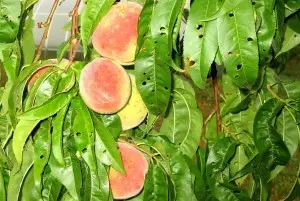
leaf curl
A prolonged, rainy, wet spring can provoke the mass development of this peach disease. The causative agent – a marsupial fungus, appears already during the growing season on newly blossomed young leaves, first with a purple tint or border, and after 7-10 days in the form of a gray coating on the back of the leaf. Shoots are mostly affected. The leaves die off, curl and fall, as a result of which the shoot is completely exposed, and also dries up or dies at the first frost. An infected peach practically does not bear fruit, the yield drops sharply, and if ovaries appear, the pericarp is severely deformed.
Prior to sporulation, peach shoots and leaves affected by curly hair are removed and burned. Before the onset of rains in the autumn period, a blue treatment is carried out with a copper-containing preparation. In the spring, the peach should be sprayed several times: the first – in the phenophase with copper oxychloride, the second – after 8-12 days with such preparations as soon, chorus with the addition of delan 65% w.g.
The photo shows leaves damaged by curl.
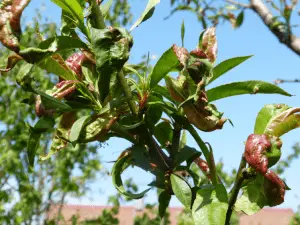
Mučnistaâ rosa
One of the most serious diseases of peach and other stone fruits. Shoots, foliage and fruits are affected by a light gray felt coating. Shoots infected with powdery mildew are deformed, lag behind in development or die off. The mushroom picker has special suckers with which it penetrates the epidermal cells of the tree, sucking out nutrients from the peach and destroying it. Conidia are carried by the wind and cause reinfection. The disease develops as quickly as possible in dry, hot weather.
It is necessary to timely remove the sources of primary infection – affected shoots and branches, fallen leaves and fruits. The main treatment is to spray topsin or topaz at the end of flowering. Simultaneous spraying with insecticides compatible with these preparations also has a beneficial effect.
In the photo below you can see an example of an infected peach and its fruits.
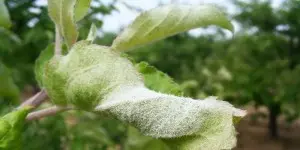
Stone fruit moniliosis
It appears in the spring during the flowering period. The flowers turn brown, wither and fall off, the leaves, annual shoots and young fruit branches also darken. The ovaries crumble, and not fallen fruits darken, deform and rot. The infection is spread by oriental codling moths, weevils, geese and bukarkas or by cross-pollination of a healthy and diseased tree. The disease actively develops during the period of wet, cool weather in the spring. In a short time, well-developed large branches and two-year-old shoots can dry out.
Regular rejuvenation of the tree and pruning of damaged shoots and fruits should be carried out. As a preventive measure, moniliosis is treated with chorus before flowering, then, after flowering, it is sprayed with topaz and a third time with topsin. This destroys all pest vectors and the fungus itself.
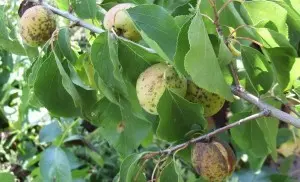
fruit rot
With this disease, the yield is significantly reduced, and may approach zero, since the peach fruits are affected, they deform, gradually rot and fall off. Numerous light gray or gray pads appear on the surface of the infected fruit. At first, the rot looks like a brown spot, which grows rapidly. The fungus-causative agent hibernates in dried fruits on a tree and begins to actively develop during the ripening of the ovaries, the size of a walnut. In the summer, several generations of the fungus appear, the disease spreads rapidly.
It is necessary to collect and destroy the damaged carrion daily, and in the fall to remove the fruits remaining on the trees. Prior to flowering, the peach must be treated with preparations such as Teldor or Topsin M. Repeated spraying is carried out at the end of flowering and during the period of fruit growth.

The main pests of peach
aphid
A small insect, mainly located on the back of the leaf. Damages young shoots, foliage, causing them to curl and dry out. With slowness in the fight, aphids can rapidly develop and damage a large number of nearby trees. At the first sign of an insect on a peach, it should be treated with potent pesticides, since aphids are resistant to weak pesticides.
Insect-damaged leaves and shoots can be seen in the picture.
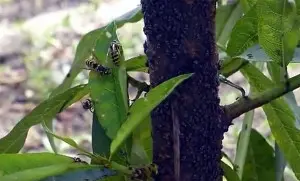
Flower weevils
This is a large group of beetles. Adults pierce buds, buds and flowers, eating away stamens, pistils, petals and less often young leaves. They are carriers of many peach fungal diseases. In the fruits, the beetles gnaw out small narrow pits in which they lay their eggs.
Effective in the fight against weevils is the chemical treatment of wood before the buds swell. Trapping belts placed above the trunk, pruning and removing buds with a brown top, cleaning the branches and trunk from exfoliating and dead bark, whitewashing the trunk with lime mortar give good results in the fight against insects.
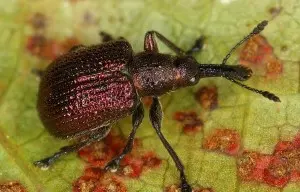
pliers
Small, broad-oval arachnids. They hibernate on the bark of a tree, at the base of large branches. The tree is greatly weakened, with a large number: the yield drops, the shoots do not develop, the leaves become discolored and fall off.
Good results are obtained by spraying the tree with organophosphorus compounds, pyrethroids and neonicotinoids. In addition, it is necessary to regularly trim the tree, keep the near-trunk area clean, whiten the trunk and install trapping belts.
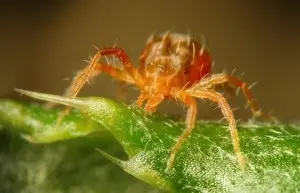
fruit moth
Narrow-winged small butterfly of a dark gray color. Caterpillars hibernate in cracks in the bark, forks. In spring, they bite into the buds, and then into young shoots, eating their core. As a result, the shoots wither and die. During development, one caterpillar can damage 5-6 shoots. Mature caterpillars hide in dry leaves, bark crevices or in the trunk circle. Butterflies, hatching from a cocoon, lay their eggs on the buds and peach flowers.
Prevention consists in cutting and burning damaged shoots, carrion and root vegetation. Also effective are regular loosening of the soil under the crown and the imposition of a trapping belt on the skeletal branches and trunk of a peach.
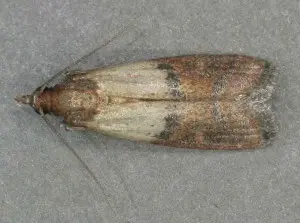
Oriental moth
This small butterfly enjoys the peach as a wintering home. On damaged shoots, in cracks and exfoliations of the bark, under fallen leaves in the near-trunk zone, insect cocoons can be found. Caterpillars eat new shoots and small ovaries, and eventually unhardened peach pits. The picture shows a developed codling moth.
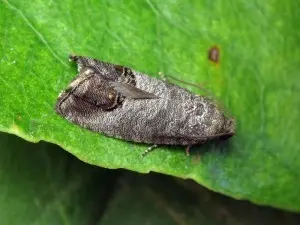
Prevention – pruning and processing
Since peach diseases can develop at lightning speed at the most favorable time for its development and destroy not only the crop, but also cause irreparable harm to the plant, preventive treatment should be carried out regularly. To prevent the development and infection of fungal diseases, blue spraying with a Bordeaux mixture or other low-toxic fungicide should be carried out 2-4 times a year. Processing is carried out in early spring, when the buds have not yet opened, and in autumn, when the tree has completely shed its leaves.
In pest control, in addition to chemical treatment, it is necessary:
- timely cut off damaged shoots, remove carrion. It is advisable to burn them at a distance of at least 15-20 m from the garden plot;
- Regularly loosen the soil in the near-stem zone under the crown, put a trapping belt on large skeletal branches and a tree trunk;
- Remove excess weeds near the tree, as well as basal shoots;
- Carefully clean the lagged bark on the trunk and branches;
- In addition, the annual application of mineral fertilizers in the spring, not only allows you to get a good harvest, but also strengthens the tree itself, increasing its resistance to disease.
Video “Peach – pests and diseases”
The video shows the available pest control methods. Talks about the prevention and treatment of the most common peach diseases.









